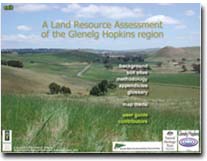Soils of the Glenelg-Hopkins Region
The Glenelg-Hopkins Region has the above Soil Orders that you can link to. These Soil Orders have been classified using the Australian Soil Classification.
Chromosols | Sodosols | Kurosols | Dermosols | Ferrosols | Vertosols | Podosols | Organosols | Tenosols | Rudosols
Broad-scale overview soil maps are presented for each Soil Order above and should only be used as a general indication of their distribution. These maps have been developed from work done by DPI's former Centre for Land Protection Research as part of the Glenelg-Hopkins Land Resource Assessment Project. This work utilised existing surveys, remote sensing information and some additional field work to develop an updated 1:100 000 soil/landform mapping coverage across the region.
 A Land Resource Assessment of the Glenelg-Hopkins Region. |
A number of soil surveys have been completed in this region at varying scales and intensity. Details about these can be found in the Soil and Land Survey Directory.
There are five main Soil Categories in the Glenelg-Hopkins Region and these are listed below. Each of these Soil Categories contain one or more Soil Orders.
- Texture Contrast Soils
- Soils Lacking Strong Texture Contrast
- Cracking Clay Soils
- Shallow Soils
- Wet Soils
Texture contrast soils are those that display strong texture contrast between the surface (A horizons) and the subsoil (B horizons) e.g. sand or loam over clay.
In the Glenelg-Hopkins Region, there is a range of soils with strong texture contrast, previously referred to as Duplex soils using the Northcote Factual Key.
Using the Australian Soil Classification there are three Soil Orders represented, based on subsoil chemistry (specifically pH):
- Kurosols
- Chromosols
- Sodosols
Chromosols have clay subsoils which are not strongly acid (i.e. pH >5.5 in water) and are non-sodic. Their surface texture ranges from loam to fine sandy loam over a clay subsoil. Chromosols are common throughout the region
Sodosols have subsoils which are not strongly acid (i.e. pH >5.5 in water) but are sodic. Their surface texture ranges from sandy loam to clay loam over medium to heavy clay. Sodosols are common throughout the region
Soils Lacking Strong Texture Contrast
There are a number of soils in the Glenelg-Hopkins Region which lack strong texture contrast between the surface and subsoil horizons. These soils have previously been referred to as Gradational soils using the Northcote Factual Key. Using the Australian Soil Classification they are classified as:
- Dermosols
- Ferrosols
Ferrosols are deep, well-structured and friable soils that have formed on basalt. They are high in free iron oxide and clay, and are generally strongly acid. They have a fairly limited distribution in the region being associated mainly with basalts to the west of Portland and Heywood.
Cracking Clay Soils
These soils are referred to as Vertosols. These are clay soils that shrink and swell, and crack as the soil dries. They are reasonably common throughout the region - especially associated with basalt on Volcanic plains and on the crests and upper slopes of the Merino Tablelands.
Shallow Soils
There are two shallow soils in the Glenelg-Hopkins Region as classified by the Australian Soil Classification:
- Rudosols
- Tenosols
Tenosols are shallow, weakly developed soils that show more profile development than Rudosols. They generally have low water holding capacity and fertility. In the Glenelg-Hopkins region, they also occur in the Nelson Dunes and Plains region as well as in granite areas around the Glenelg River and the Grampians.
Wet Soils
These soils are referred to as Hydrosols and are saturated for many months of the year. They are not mapped here (due to mapping scale constraints) but do occur in the region often associated with former lake beds.


